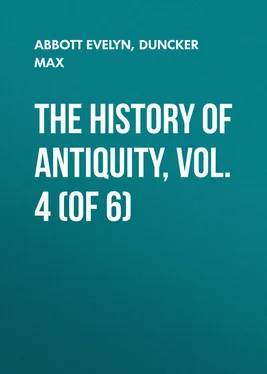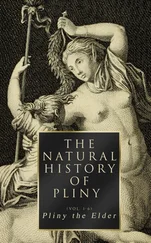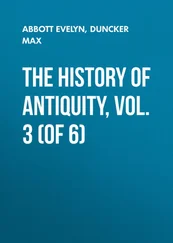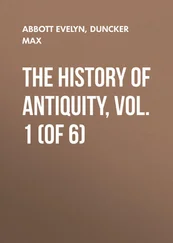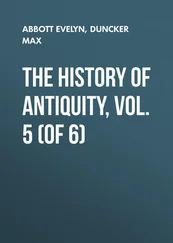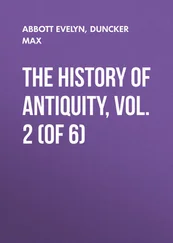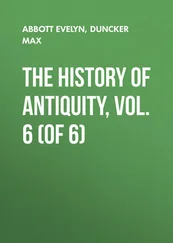Max Duncker - The History of Antiquity, Vol. 4 (of 6)
Здесь есть возможность читать онлайн «Max Duncker - The History of Antiquity, Vol. 4 (of 6)» — ознакомительный отрывок электронной книги совершенно бесплатно, а после прочтения отрывка купить полную версию. В некоторых случаях можно слушать аудио, скачать через торрент в формате fb2 и присутствует краткое содержание. Жанр: foreign_antique, foreign_prose, Историческая проза, на английском языке. Описание произведения, (предисловие) а так же отзывы посетителей доступны на портале библиотеки ЛибКат.
- Название:The History of Antiquity, Vol. 4 (of 6)
- Автор:
- Жанр:
- Год:неизвестен
- ISBN:нет данных
- Рейтинг книги:5 / 5. Голосов: 1
-
Избранное:Добавить в избранное
- Отзывы:
-
Ваша оценка:
- 100
- 1
- 2
- 3
- 4
- 5
The History of Antiquity, Vol. 4 (of 6): краткое содержание, описание и аннотация
Предлагаем к чтению аннотацию, описание, краткое содержание или предисловие (зависит от того, что написал сам автор книги «The History of Antiquity, Vol. 4 (of 6)»). Если вы не нашли необходимую информацию о книге — напишите в комментариях, мы постараемся отыскать её.
The History of Antiquity, Vol. 4 (of 6) — читать онлайн ознакомительный отрывок
Ниже представлен текст книги, разбитый по страницам. Система сохранения места последней прочитанной страницы, позволяет с удобством читать онлайн бесплатно книгу «The History of Antiquity, Vol. 4 (of 6)», без необходимости каждый раз заново искать на чём Вы остановились. Поставьте закладку, и сможете в любой момент перейти на страницу, на которой закончили чтение.
Интервал:
Закладка:
132
Von Gutschmid, "Beiträge," s. 76 ff. See below.
133
P. 484, ed. Wilson.
134
Von Gutschmid, loc. cit. s. 85 ff.
135
That the main portions of the Epos in their present form cannot be older, is clear from the views of the worship of Vishnu and Çiva which prevail in the poem. These forms of worship first obtained currency in the fifth and fourth centuries B.C. (see below). It is also clear from the identification of Vishnu and Krishna, of Rama and Vishnu; the deeply felt Brahmanic anti-Buddhist tendencies, seen in such a marked manner in the Ramayana; the form of philosophic speculation, and the application of astrology, which are characteristic of the Epos in its present state; and finally from the mention of the Yavanas as the allies of the Kurus, and Dattamira, i. e. Demetrius, the king of the Yavanas. This king reigned in Bactria in the first half of the second century B.C. (Lassen, loc. cit. 1, 557). Another king of the Yavanas who is mentioned is Bhagadatta, i. e. apparently, Apollodotus, the founder of the Græco-Indian kingdom in the second half of the first century B.C. (Von Gutschmid, "Beiträge," s. 75). We are led to the same result by the descriptions of Indian buildings, of paved roads and lofty temples, which were first built by the Brahmans in opposition to the stupas of the Buddhists. Lassen places the important pieces of the Mahabharata, in their present form, between Kalaçoka and Chandragupta, i. e. between 425-315 B.C. ( loc. cit. 12, 589 ff.) Benfey places them in the third century B.C., A. Weber in the first century. The Mahabharata, which according to the statement found in the poem (1, 81) originally had only 8,800 double-verses, now numbers 100,000: A. Weber, "Acad. Vorlesungen," s. 176. The old form of the Mahabharata is much anterior to the fifth century B.C.; certain passages of the present poem are much later: A. Weber, "Indische Skizzen," s. 37, 38. When Dion Chrysostom remarks (2, 253, ed. Reiske) that the Homeric poems were sung by the Indians in their own language – the sorrows of Priam, the lamentation of Hecuba and Andromache, the bravery of Achilles and Hector – Lassen is undoubtedly right in referring this statement to the Mahabharata, and putting Dhritarashtra in the place of Priam, Gandhari and Draupadi in the place of Andromache and Hecuba, Arjuna and Suyodhana or Karna in the place of Achilles and Hector ("Alterth." 22, 409). It is doubtful whether the remark of Chrysostom is taken from Megasthenes. That the Ramayana is later in style than the Mahabharata will become clear below.
136
"Vishnu-Purana," ed. Wilson, p. 380, seqq.
137
Lassen, "Ind. Alterth." 12, Anhang xviii. n. 4.
138
In the Rigveda we find: "If you, Indra and Agni, are among the Druhyus, Anus or Purus, come forth."
139
Lassen, loc. cit. 1, xxii. n. 15.
140
"Rigveda," 1, 31, 4; 1, 31, 17; 7, 18, 13.
141
According to the Brahmanic recension of the poem which we now possess, Samvarana is able to obtain the daughter of the god only by the mediation of a sacred priest. The king therefore bethinks him of Vasishtha, who ascends to the god of light and obtains his daughter for the king. Lassen, "Ind. Alterth." 12, Anhang xxvi.
142
Lassen, "Ind. Alterth." 12 656, n. and 12 850.
143
A. Weber, "Ind. Literaturgesch." s. 1262.
144
Manu, 7, 90, 93. Yajnavalkya, 1, 323-325.
145
Panini in M. Müller, "Hist. of anc. Sanskrit Literature," p. 44, n. 2.
146
Manu, 9, 59.
147
M. Müller, loc. cit.
148
"Vishnu-Purana," ed. Wilson, p. 440. Lassen, "Ind. Alterth." 12, 68 ff.
149
In Panini Krishna is called a god, but also a hero. M. Müller, "Hist. of anc. Sanskrit Lit." p. 45 n.
150
On the form of the Rama legend in the Daçaratha-Jataka, cf. A. Weber, "Abh. Berl Akad." 1870. The Vishnu-Purana enumerates 33 kings of the Koçalas from Daçaratha to Brihadbala, who falls in the great battle on the side of the Kurus. Including these this Purana makes 60 kings between Manu and Daçaratha. For the same interval the Ramayana has only 34 names, of which some, like Yagati, Nahusha, Bharata, are taken from the genealogical table of the kings of the Bharata, others, like Pritha and Triçanku, belong to the Veda. We have already seen that the series of the Bharata kings give about ten generations between the time when they gained the upper hand on the Yamuna and upper Ganges, i. e. the time of Kuru and Duryodhana. The Koçalas forced eastward by the Bharatas would thus have existed on the Sarayu from 23 generations before Kuru. Wilson, "Vishnu-Purana," p. 386.
151
Cunningham, "Survey," 1. 301 ff.
152
Lassen, loc. cit. 12, 168 n.
153
Lassen, "Ind. Alterth." 12, 168.
154
Lassen, loc. cit. 12, 671, 951.
155
Manu, 1. 91.
156
Lassen, loc. cit. 12, 966 n.
157
"Samaveda," 1, 6, 1, 4, 5, in Benfey's translation.
158
Muir, "Sanskrit Texts," 5, 266 ff.
159
"Rigveda," 1, 40, 5, in Muir, loc. cit. 5, 272 ff.
160
"Rigveda," 10, 68, 8 ff. Roth, "Z. D. M. G." 1. 75.
161
Brahmán , from the root barh , connected with the root vardh (to become, to grow), means to raise, to elevate. The masc. brahmán means "he who elevates, makes to increase;" the neuter bráhman means first, "growth," the "creative power," and then, "the elevating and elevated mood," the prayer and sacred form of words, the creative, reproducing power. A. Weber, "Ind. Studien," 2, 303; 9, 305.
162
Roth, loc. cit. 1. 73.
163
Muir, loc. cit. 5, 382.
164
So in Manu, e. g. 6. 65. Atman means " breathing ;" paramatman "the highest breathing."
165
"Rigveda," 10, 72, 1-3; 10, 129, 1-6, in Muir, loc. cit. 5, 48 ff. 356.
166
Manu, 1, 28, 29.
167
"Rigveda," 10, 90; Manu, 1, 31 and in the Puranas; Muir, "Sanskrit Texts," 5, 371. A. Weber, "Ind. Studien," 9, 7.
168
Manu, 1, 88-91, and in many other places.
169
In Manu, 4, 88-90 (cf. 12, 75, 76) eight hells are mentioned and described, in each of which the torments grow worse as the offences are more serious. The Buddhists retain these eight hot hells, and add eight cold; Burnouf, "Introduction à l'histoire du Bouddhisme," p. 320, 366, 367, 201. The Singhalese have increased the number to 136, the Siamese to 462. Koppen, "Relig. des Buddha," s. 244. Cf. A. Weber, in "Z. D. M. G." 9, 237.
170
e. g. Manu, 9, 335.
171
Manu, 12, 43, 44.
172
Интервал:
Закладка:
Похожие книги на «The History of Antiquity, Vol. 4 (of 6)»
Представляем Вашему вниманию похожие книги на «The History of Antiquity, Vol. 4 (of 6)» списком для выбора. Мы отобрали схожую по названию и смыслу литературу в надежде предоставить читателям больше вариантов отыскать новые, интересные, ещё непрочитанные произведения.
Обсуждение, отзывы о книге «The History of Antiquity, Vol. 4 (of 6)» и просто собственные мнения читателей. Оставьте ваши комментарии, напишите, что Вы думаете о произведении, его смысле или главных героях. Укажите что конкретно понравилось, а что нет, и почему Вы так считаете.
